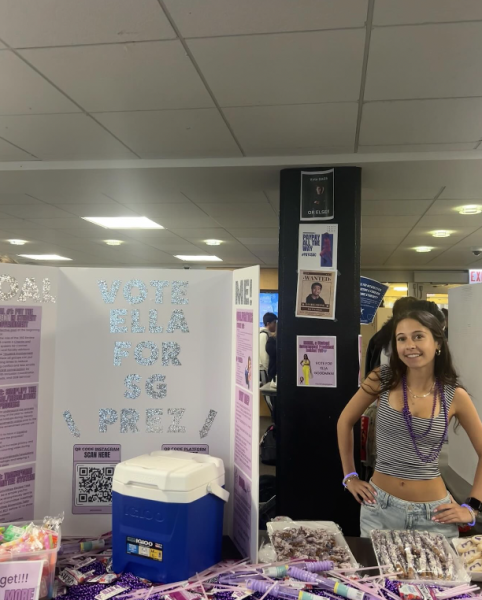When Parker Feels Even Smaller
From First Grade to Senior Year, Learning Resources Teaches Advocacy
On Thursday during conference, Upper School Learning Resource teacher Bridget Walsh’s room was full juniors and seniors completing assignments and projects due before the February recess. Seated at her desk in the corner closest to the door, Walsh was available to answer questions. Walsh has been working at Parker for five years.
One of the most commonly discussed aspects of Learning Resources, especially in the high school, is the extended time accorded to eligible students. There are two types of extended time: the kind taken for classroom tests or exams and the kind taken for standardized tests like the ACT and SAT.
As students reach high school, Parker’s policy requires that a student must receive outside testing and diagnosis in order to receive extended time. “The school policy is that a student has to provide a neuropsych that distinguishes that they actually do have a disability,” Walsh said. “Those disabilities range from a reading or a math to anxiety or depression.”
For students who are diagnosed with a psychological condition like anxiety or depression, extended time cannot be used as their only means of treatment. “It shouldn’t just be, ‘Yeah, I have an anxiety disorder, so now I get extended time,’” Walsh said. “The point of that is to weave in services for that person. Whether that be internal, through Gary Childrey or Bonita Donahue, or outside, we like to have some open dialogue.”
“There are many psychological disorders or phenomena that interfere with testing,” Upper School Counselor Dr. Gary Childrey said. “Some of it can be depression or anxiety, just to name two things. Another thing could be Attention Deficit Disorder with or without Hyperactivity.”
While not always the case, often psychological and attention disorders act together within a given student. “These three phenomena or elements, not the total list, but they are not necessarily acting alone,” Childrey said. “They are integrated. It’s not unusual to have someone with attention problems who gets anxious because they might realize that they can’t focus, and they have a chronic anxiety that is secondary to the attention or focusing problems.”
Even beyond more general anxiety and depression, many students simply struggle with anxiety solely triggered by tests and exams. “They can get on stage–they’re fine during the week, they can study well,” Childrey said, “but when they get into a competitive assessment sort of issue, the anxiety really comes.”
Through counseling and work with the Learning Resources department, Childrey works to identify different elements that individual students need to focus on.
Specifically with test-anxiety, it can be difficult for students who are unfamiliar with the Learning Resources program to recognize all of the work that multiple departments put into supporting students. “Let’s say they give an IQ test, and the person’s IQ is 128 or 130–that’s in the 90-plus percentile, and they do their homework, they can write papers totally well, their teachers are not complaining that they’re not handing in homework, but they get into a test situation, and they’re getting Cs and Ds,” Childrey said. “Through testing, you get a baseline, and when there’s really a large discrepancy between performance and their ability, then you might suspect the legitimacy.”
According to Childrey, for test specific anxiety, there is an official and unofficial way to go about assessing the situation. The official method would be for a student to go to an outside phycologist in which a series of tests, often including an IQ test and student interviews, try to find an overall feeling for an individual student’s performance. This baseline can then be compared to in school performance. The more unofficial way to go about this is for teachers at the school to identify large discrepancies between assessments and in class performance. Regardless of the officiality of the path, parents, teachers, and students are involved in determining next steps regarding extended time for test-specific anxiety.
On some level, to be sure, just about every student experiences stress or anxiety while taking a test. “Everyone experiences a little anxiety, and anxiety may not necessarily be a bad thing,” Childrey said. “It might be really stimulating and really get you going.”
Some people at Parker, however, suspect whether or not certain students really deserve extra time. “I would say that that could be the case for a small number of people,” Childrey said. “Can our system be abused? The answer is yes, it can be, but not by a larger group of people–by some.”
Senior Danny Sickle agrees. “There are some people who have extended time that don’t need it,” Sickle said, “and I don’t know enough about everyone’s diagnostics but I remember in middle school people would say ‘I’m certified illiterate or ‘I’m certified stupid and that’s why I go to Learning Resources and that’s why I don’t take a language’ even though they are perfectly capable of doing many things.”
Since fourth grade Sickle has been filling out the paperwork that has led him to use extended time. That being said, other than using extended time, Sickle has chosen to remain separate from other services that the Learning Resources department offers. “I didn’t want to abuse my extended time,” Sickle said, “and there are definitely people who need extended time and who need Learning Resources but I thought I was already given such, not an advantage, but extended time in some ways can overcompensate, so I didn’t want to go too far.
Walsh understands why some students might question those with extra time. “I don’t see it as a problem so much as I see, unfortunately, that it has to do with the competitive nature of Parker,” Walsh said. “It’s hard to see other people getting what seems to be an advantage. We deal with this in other realms of culture as well. Seeing other people get an advantage seems fair to the people who have always had the advantage. So sometimes that’s what it comes into, ‘Wow, these kids are getting extended time and that doesn’t need it– I know that kid.’”
Despite qualifying and using extended time, Sickle wholeheartedly disapproves of the practice. “I am also very against extended time, even though I have it,” Sickle said. “I’m against extended time because I think it advantages some kids and disadvantages others. It disproportionately affects kids with money and it took thousands upon thousands of dollars to go to the therapist that got me extended time and go through the paperwork.”
It’s not easy to game the system, according to Walsh. “There’s a big circle of people that get these neurodiagnostic exams completed,” Walsh said. “A kid can’t just go report to their therapist that they have anxiety. It’s either me or a multitude of teachers of some combination that report observations and where they see issues.”
Overall Walsh finds the system fair but wishes there was more communication about expectations that the Learning Resources department has. She said, “There aren’t very many contentious conversations, and I think some people need to be educated about it, but I can’t really cite any times where I felt, particularly for a testing accommodation, that one of our students has not gotten the accommodation that they need.”
Unlike in the high school, Lower School Learning Resources teacher Alison Kimball focuses very little on extended time. Kimball, like Walsh, works with students who might be struggling for any number of reasons in the classroom. In the lower school, students are by no means required to receive any formal outside testing. Kimball said, “They’re referred to the Learning Resource program through the classroom teacher.”
For Sickle, a lot of the problems come down to how small Parker can feel. “I have not shared with anyone my diagnosis and I have not asked anyone,” he said. “I know some people’s because they’re frank about it and say, ‘I have this thing.’”
“We really hope not to have kids be diagnosed and labeled as needing accommodations,” Walsh said. “That’s really the hope. For a long time, and this is true in public schools as well, we keep them out of the Learning Resource program by providing them in class accommodations. So that’s why you see more of the LR teachers, we call it push-in in special ed, push into the classroom and help a small group of students or circulate. That’s trying to keep the students from necessarily needing accommodations.”
Through weekly meetings with teachers and visits to the classroom Kimball’s goal is to make sure that each students is understood as best as possible. “We’re providing teachers right up front with how to best teach these kids and what strategies to use,” Kimball said, “so we can keep them in the classroom as much as possible.”







